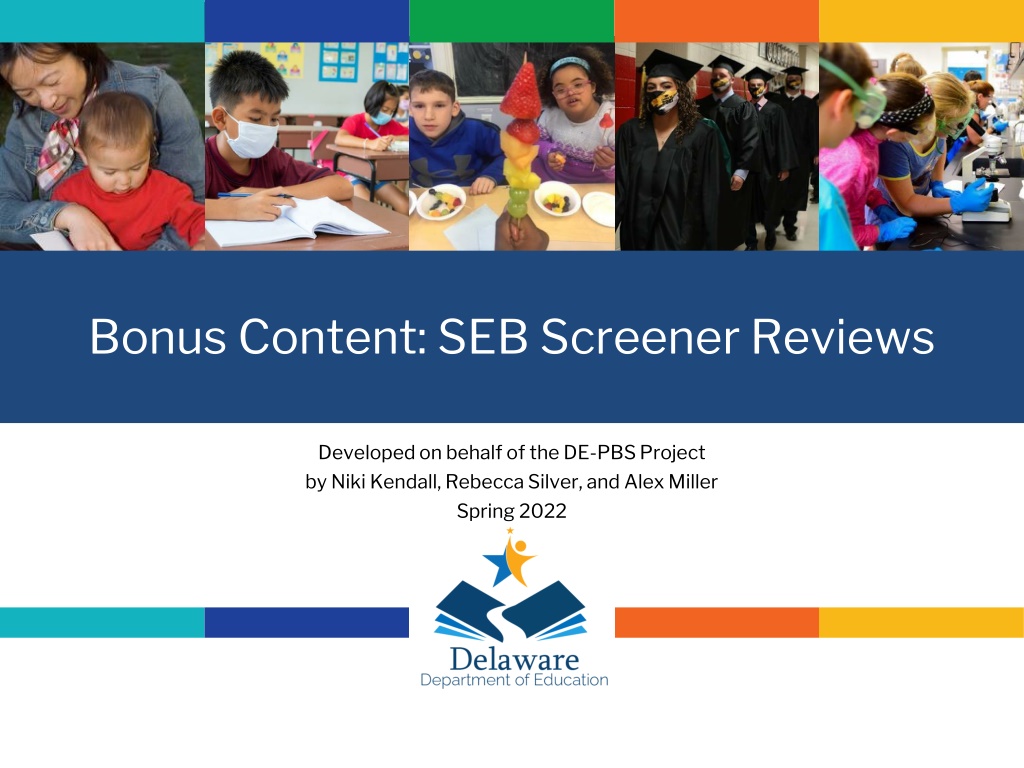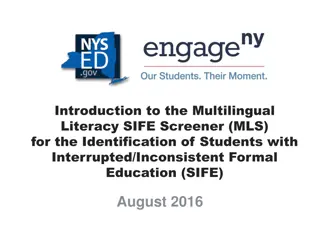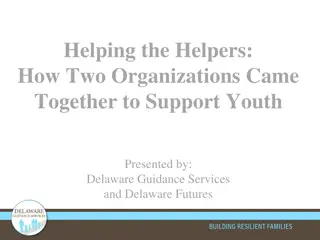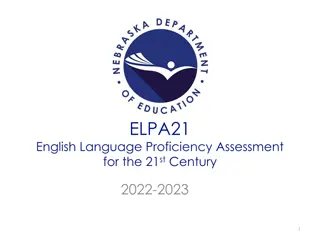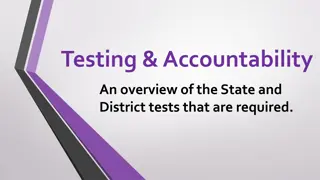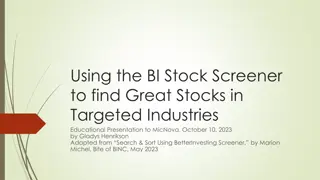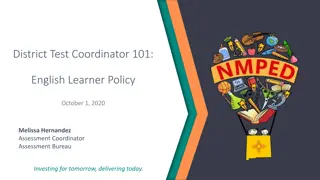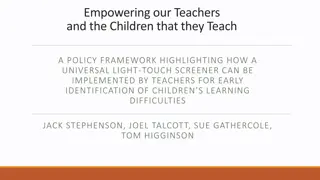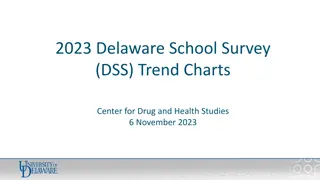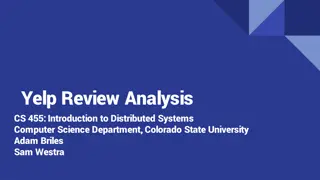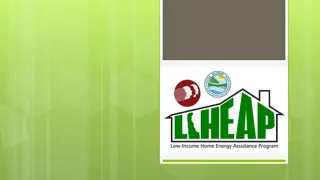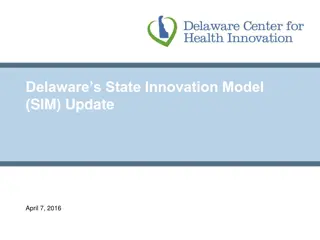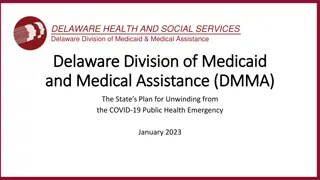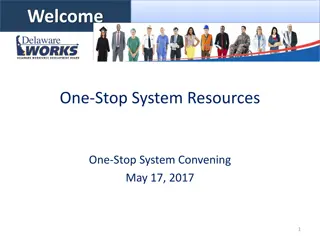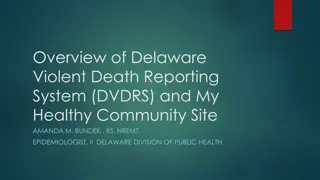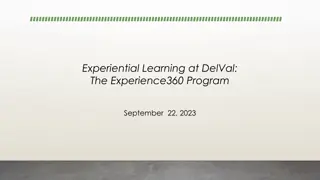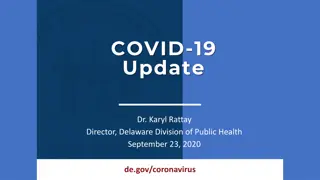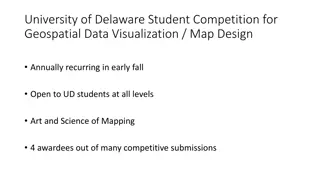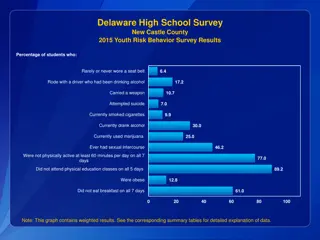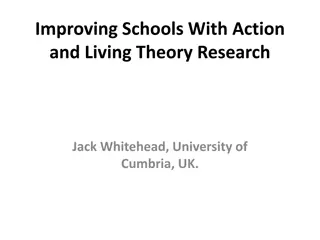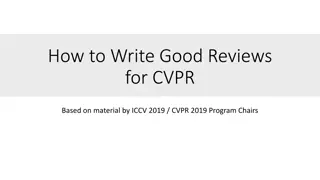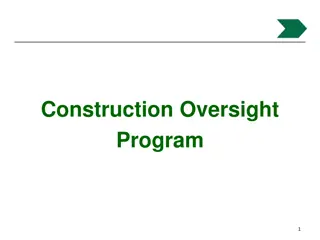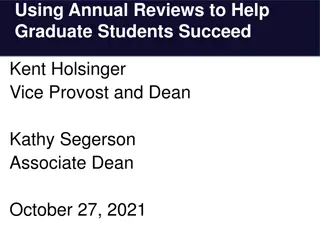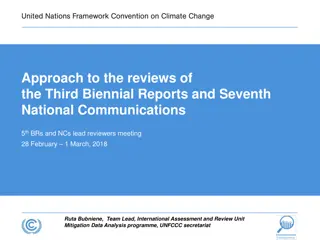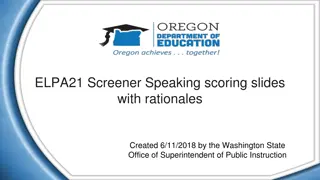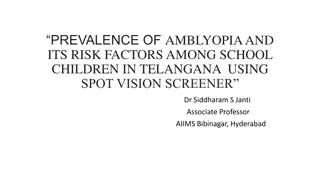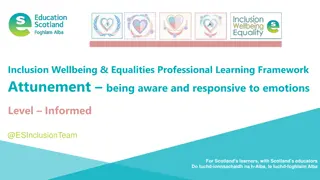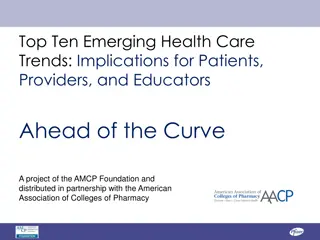SEB Screener Reviews for Delaware Educators
SEB Screener Reviews were developed for the DE-PBS Project in Spring 2022 to support Delaware educators in building knowledge and skills in Positive Behavior Support (PBS). The project aims to create safe and caring learning environments that promote social-emotional and academic development. The screener reviews provide insights into the usability and defensibility of common SEB screeners used across Delaware LEAs, aiding teams in their selection process. The Social, Academic, and Emotional Behavior Risk Screener (SAEBRS) is discussed as a tool for identifying risk factors for emotional and behavioral issues, with detailed scoring and interpretation guidelines provided.
- SEB Screener Reviews
- DE-PBS Project
- Positive Behavior Support
- Delaware educators
- Social
- Academic
- Emotional Behavior
- SEB screening tools
Download Presentation

Please find below an Image/Link to download the presentation.
The content on the website is provided AS IS for your information and personal use only. It may not be sold, licensed, or shared on other websites without obtaining consent from the author. Download presentation by click this link. If you encounter any issues during the download, it is possible that the publisher has removed the file from their server.
E N D
Presentation Transcript
Bonus Content: SEB Screener Reviews Developed on behalf of the DE-PBS Project by Niki Kendall, Rebecca Silver, and Alex Miller Spring 2022
The DE-PBS Project serves as a technical assistance center for the Delaware DOE to actualize the vision to create safe and caring learning environments that promote the social-emotional and academic development of all children. The statewide initiative is designed to build the knowledge and skills of Delaware educators in the concepts and evidence-based practices of Positive Behavior Support (PBS) as a Multi-tiered System of Support (MTSS). https://www.delawarepbs.org/universal-screening/
Webinar Topics Webinar 1: introduction Webinar 2: universal SEB screener selection Webinar 2 (Bonus Content): SEB screener reviews Webinar 3: universal screening readiness, resource mapping, gap analysis Webinar 4: parental consent, action planning and gaining stakeholder buy in Webinar 5: data-based decision making
These slides provide information about the usability and defensibility of several common SEB screeners currently in use across Delaware LEAs. Teams can use these slides and the screener tool exploration worksheet during their screener selection process.
Social, Academic, and Emotional Behavior Risk Screener (SAEBRS) Authors: Dr. Stephen Kilgus & Dr. Nathaniel von der Embse (2014)
Does the SAEBRS Meet your Need? Purpose: identify risk for emotional and behavioral problems; includes broad factor score, as well as social, emotional, and academic behavior factors Informant: Teacher form (SAEBRS): grades K-12 Self-report form (mySAEBRS): grades 2-12 Low Risk Some Risk High Risk Scale General Behavior 0-23 24-36 37+ Social Behavior 0-7 8-12 13+ Interpretation Guide: Risk for social behavior problems: student displays behaviors that limit his/her ability to maintain age appropriate relationships with peers and adults. Risk for academic behavior problems: student displays behaviors that limit his/her ability to be prepared for, participate in, and benefit from academic instruction. Risk for emotional behavior problems: student displays actions that limit his/her ability to regulate internal states, adapt to change, and respond to stressful/challenging events. Academic Behavior 0-5 6-9 10+ Emotional Behavior 0-11 12-16 17+ Risk based on national normative sample: Low risk: scores above the 16th percentile Some risk: scores from the 3rd to the 16th percentile High risk: scores below the 3rd percentile
Is the SAEBRS Appropriate? Guidance for Prevention and Intervention Development SAEBRS is a combined problem based and strength based tool The authors have aligned the SAEBRS domains with the five CASEL social- emotional domains and recommend the following for each area: o Social Behavior Domain: look for SEL curriculum that focus on relationship skills, friendship building, impulsiveness, or socially appropriate behavior o Emotional Behavior Domain: look for SEL curriculum that targets coping strategies, adaptability, or positive psychology (e.g., gratitude and hope) o Academic Behavior Domain: look for SEL curriculum that focuses on organization, self-monitoring, and motivation. Also focus on effective instruction to increase student engagement
Is the SAEBRS Usable? Cost: o $3 per student (per year) for FastBridge Behavior Suite (SAEBERS and mySAEBRS) Administration & Scoring o About 3-5 minutes per student (highly efficient) Teacher form: 19 items Student form: 20 items o Completed and automatically scored online Data management system: o FastBridge by Illuminate Education Accommodations: o mySAEBRS: available in English and Spanish Repeatability: Not intended for progress monitoring but publishers indicate it can be used 3 times per year
Is the SAEBRS Defensible? New national norms released summer 2021, based on data from 2018- 2019 and 2019-2020 school years An iterative random selection procedure was used to generate samples across 100 schools demographically matched to the U.S. school population for gender, race/ethnicity, and free or reduced lunch benefits Reliability Coefficient Descriptor r = .79 - .94 Adequate to Strong Internal consistency reliability r = .91 Strong Test-retest reliability r = .41 - .48 Limited Inter-rater reliability
SAEBRS Defensibility Validity Concurrent validity Strong between academic scale and academic tests Strong between SAEBERs and other established screening measures (e.g., BESS) Predictive validity Strong for ODRs, suspensions and academic CBMS and testing; not as strong for absenteeism Content Validity Initial items were reviewed by experts (including school psychology professors and doctoral students) and sorted into categories based on expert judgment. Expert panel also provided feedback on item wording Construct validity Exploratory Factor Analysis and Confirmatory Factor Analysis demonstrated that the overall, academic behavior and social behavior scales were supported
SAEBRS - Conclusions Excellent norms Good reliability and validity as evidenced in numerous peer reviewed journal articles Research supports it s utility as an initial screening to identify students at risk for future discipline and academic problems Constructs (Social, Academic, and Emotional) are easily interpreted by numerous stakeholders Well researched interpretation guidance to help teams determine where to focus their efforts FastBridge data can be imported to other data dashboards (e.g., Panorama s Student Success Platform) All reliability and validity research conducted with teacher versions; less is known about the mySAEBRS Parent version is not yet available
SAEBRS - Quotes from the Field The SAEBRS helped us by providing our teachers with a standardized approach to collecting data on the social, emotional, and academic needs for our students. It makes screening for SEBW needs just as easy as screening for academic needs. - Heather Godwin, District Student Services Coordinator at Red Clay Consolidated School District The SAEBRS helped us take what seemed to be an overwhelming idea of identifying student social and emotional needs to one that was feasible and manageable. - Meghan Covert, Restorative Practices Coach at William Penn High School
SAEBRS - Resources & References Resources DE PBS SAEBRS Data Analysis Template Publisher website: https://www.illuminateed.com/products/fastbridge/social-emotional-behavior-assessment/saebrs/ Illuminate Education. (n.d.). SAEBRS overview. https://fastbridge.illuminateed.com/hc/en-us/articles/1260802463290-SAEBRS- Overview Kilgus, S. & von der Embse, N. (2021). Improving SEL with social-emotional assessment [Implementation Guide]. Illuminate Education. https://drive.google.com/file/d/1mo1jAKGLvlWAHKklOV20DeI-SgtNGU9Q/view References Illuminate Education. (2021). FastBridge social emotional behavior national norms report. https://fastbridge.illuminateed.com/hc/en- us/article_attachments/4404315314203/FastBridge_Social_Emotional_Behavior_National_Norms_Report_Final__2021_.pdf Kilgus, S. P., Chafouleas, S. M., & Riley-Tillman, T. C. (2013). Development and initial validation of the Social and Academic Behavior Risk Screener for Elementary Grades. School Psychology Quarterly,28(3), 210 226. https://doi.org/10.1037/spq0000024 Kilgus, S. P., Eklund, K., von der Embse, N. P., Taylor, C. N., & Sims, W. A. (2016). Psychometric defensibility of the Social, Academic, and Emotional Behavior Risk Screener (SAEBRS) Teacher Rating Scale and multiple gating procedure within elementary and middle school samples. Journal of School Psychology, 58, 21 39. https://doi.org/10.1016/j.jsp.2016.07.001 Kilgus, S. P., Sims, W. A., von der Embse, N. P., & Riley-Tillman, T. C. (2015). Confirmation of models for interpretation and use of the Social and Academic Behavior Risk Screener (SAEBRS). School Psychology Quarterly, 30(3), 335 352. https://doi.org/10.1037/spq0000087 Kilgus, S. P., Sims, W. A., von der Embse, N. P., & Taylor, C. N. (2016). Technical adequacy of the Social, Academic, and Emotional Behavior Risk Screener in an elementary sample. Assessment for Effective Intervention, 42(1), 46 59. https://doi.org/10.1177/1534508415623269 Whitley, S. F., & Cuenca-Carlino, Y. (2020). Examining the technical adequacy of the Social, Academic, and Emotional Behavior Risk Screener. Assessment for Effective Intervention, 46(1), 67 75. https://doi.org/10.1177/1534508419857225
Strengths & Difficulties Questionnaire (SDQ) Author: Dr. Robert Goodman (1997, 2002)
Is the Strengths and Difficulties Questionnaire (SDQ) Appropriate? Purpose: Identify children and adolescents with existing emotional, behavioral, or concentration problems severe enough to warrant clinical diagnoses (according to DSM-IV criteria); also measures prosocial and relationship skills Informant o Teacher & parent forms: ages 3-18+ Self-report: ages 11-18+ Low Medium Difficulties High Scale Difficulties Difficulties o Total Difficulties 0-11 12-15 16-40 Conduct Problems 0-2 3 4-10 25 items (5 items per subscale) o Total Difficulties = sum of all subscales except Prosocial Behavior Hyperactivity/Inattention 0-5 6 7-10 Emotional Symptoms 0-3 4 5-10 Peer Problems 0-2 3 4-10 Categorizes students into 3 bands: low, medium, or high difficulties Prosocial Behavior 8-10 6-7 0-5
Is the SDQ Usable? Cost Free if administering & scoring manually Online: $0.50-$1.00 per student (depending on number of raters used) Administration & Scoring 3-5 minutes per student Manual or online No minimum training required Data management system: SDQPlus & SDQblockchain - allows for organization of individual students into groups (e.g., classes, grade levels, schools, etc.) Accommodations Languages: 70+ Readability: varies by subscale; ranges from 5th to 8th grade (ages 10-14); avg = 6th grade (age 12) (Patalay et al., 2018) Repeatability: Not recommended for progress monitoring
Is the SDQ Defensible? Originally normed in UK in 2001 US normative data released in 2005 (recency not adequate) o SDQ included in the 2001 National Health Interview Survey (NHIS) o 9,878 children in the survey aged 4-17 (good sample size) o Number of children equally distributed by age and gender o Respondents included parents (biological, adoptive, or step: 92%) and grandparents (4.4%) o US normative data available for Parent Report only (not for Child or Teacher report) Note: 2001 NHIS employs a complex sampling design that includes clustering, stratification, and an oversampling of African American and Hispanic households Bourdon et al. (2005)
SDQ Defensibility - Reliability Internal consistency reliability Test-retest reliability (4-6 months) Inter-rater reliability Adequate (r = .80) Limited (r = .62) Student Limited Adequate (r = .82) Limited (r = .72) Student & parent: r = .48 Parent Parent & teacher: r = .46 Adequate (r = .87) Adequate (r = .80) Teacher & student: r = .33 Teacher Jenkins et al. (2014)
SDQ Defensibility - Validity Predictive Validity Convergent Validity Content Validity CBCL ASEBA Sensitivity Specificity Adequate Limited (.23) Strong (.94) Adequate (.75) Student Not tested Evidenced by current classification concepts, previous factor analysis, and other studies Limited (.47) Strong (.94) Adequate (.87) Adequate (.81) Parent Limited (.43) Strong (.95) Teacher Not tested Not tested Jenkins et al. (2014)
SDQ - Conclusions Multirater Available in 70+ languages Measures strength in addition to risk factors Easy to administer, score, and interpret (no minimum training required) Free if administering and scored by hand o Can be administered and scored online ($0.50 per $1.00/student) Data management system is somewhat difficult to use Provides a total difficulties and impact score to improve specificity Not recommended for progress monitoring Limited info regarding standardization sample and evidence of reliability & validity No published manual available Normative data and psychometric info are not well organized No official administration guide
SDQ - Resources & References Resources DE PBS SDQ Data Tools SDQ Template (grades K-5) and SDQ Template (grades 6-12) Publisher website: https://www.sdqinfo.org/ https://youthinmind.com/products-and-services/sdq/ https://sdqscore.org/ References Bourdon, K. H., Goodman, R., Rae, D. S., Simpson, G., & Koretz, D. S. (2005). The Strengths and Difficulties Questionnaire: U.S. normative data and psychometric properties. Journal of the American Academy of Child & Adolescent Psychiatry, 44(6), 557 564. https://doi.org/10.1097/01.chi.0000159157.57075.c8 Goodman, A., & Goodman, R. (2009). Strengths and difficulties questionnaire as a dimensional measure of child mental health. Journal of the American Academy of Child and Adolescent Psychiatry, 48(4), 400 403. https://doi.org/10.1097/CHI.0b013e3181985068 Jenkins, L. N., Demaray, M. K., Wren, N. S., Secord, S. M., Lyell, K. M., Magers, A. M., Setmeyer, A. J., Rodelo, C., Newcomb-McNeal, E., & Tennant, J. (2014). A critical review of five commonly used social-emotional and behavioral screeners for elementary or secondary schools. Contemporary School Psychology, 18(4), 241 254. https://doi.org/10.1007/s40688-014-0026-6 Patalay, P., Hayes, D., & Wolpert, M. (2018). Assessing the readability of the self-reported Strengths and Difficulties Questionnaire. BJPsych Open, 4(2), 55 57. https://doi.org/10.1192/bjo.2017.13
SDQ - Quote from the Field I thought the content of the SDQ screener was good. I appreciated that it screened for strengths as well as concerning things, especially on an elementary school level. It was nice that the screener started off short and concise, but if the student was starting to flag for concerns, it knew to branch off and ask follow up questions. The reports that came out of the SDQ were helpful, and we were able to use that data to guide our morning meetings, determine what students needed services, and prioritize the students who were flagged for needing supports. We also appreciated the reports at the end of the screener that guided us to what supports would be helpful for each student. On the other hand, I thought the data platform was out of date. And although we were able to access technical support easily from the publishers, the website was also dated and made administration difficult. Amy Goodhue, LCSW, Clinical Counselor at Long Neck Elementary School in Indian River School District -
Student Risk Screening Scale - Internalizing and Externalizing (SRSS-IE) Authors: Original screener by T. Drummond (1994) Updated by Lane & Menzies (2009)
Is the SRSS-IE Appropriate? Purpose: The SRSS-IE is used to identify students who may be at risk for challenging antisocial behaviors and to better inform instruction. Teachers rate students on items related to both internalizing and externalizing behaviors. Grades K-12, teacher report only 12 items for elementary school (7 externalizing, 5 internalizing) 13 items for middle & high school (7 externalizing and 6 internalizing) Categorizes students into 3 bands based on cut scores for both subscales separately o Low risk, medium risk, or high risk
Is the SRSS-IE Usable? Cost o Available online for free access Administration & Scoring o Guidance documents and presentations for districts and site-level coordinators available online o Teachers directly rate students in the excel file or google sheet o Scores automatically generate once item responses have been entered for each question for a student o A teacher can complete screening for class in about 15-20 minutes Data management system: o No specific data management system is provided, but guidance is available for How districts may want to organize files for staff How teachers use the excel sheet to enter their scores o Customizable score reporting PowerPoint template is available Repeatability: o Is intended to be used 3 times per year (4-6 weeks after the school year starts, prior to winter break, and 6 weeks prior to the end of the school year)
Is the SRSS-IE Defensible? No technical manual available yet, but author of tool (Kathleen Lane) working under a grant to publish manual based on current, ongoing research Cut scores developed by research in schools; but not nationally normed Test-Retest Reliability (within the same academic year) Test-Retest Reliability (across academic years) Internal Consistency Reliability Inter-Rater Reliability Moderate to Adequate (r = .76 - .89) Limited to Adequate (r =.47- .75) Limited (r = .23 - .35) Limited (r = .28 - .50) Predictive validity for risk level and ODRs/in-school suspensions and GPA/course failures, up to years after SRSS screening Convergent validity with SSBD and SDQ, internalizing subscale of the Teacher Report Form Construct validity: Factor analysis confirms existence of internalizing and externalizing subscales
SRSS-IE - Conclusions Responsive to current needs - added questions related to COVID-19 for additional consideration/information (NOT included in scoring) Several studies indicating good reliability and validity, technical manual forthcoming and should provide more information Plenty of free resources and trainings online to assist in preparation and use at the district and school level Time and cost efficient Schools can look at school-wide data for program evaluation Elementary School, and Middle/High School Excel versions are available on the DE-PBS website Teacher report only Does not consider student or family voice
SRSS-IE - Resources & References Resources Website: https://www.ci3t.org/screening DE PBS SRSS-IE Data Tools o SRSS-IE (grades K-5) o SRSS-IE (grades 6-12) References Lane, K. L., Oakes, W. P., Ennis, R. P., Cox, M. L., Schatschneider, C., & Lambert, W. (2013). Additional evidence for the reliability and validity of the Student Risk Screening Scale at the high school level: A replication and extension. Journal of Emotional and Behavioral Disorders, 21(2), 97 115. https://doi.org/10.1177/1063426611407339 Lane, K. L., Oakes, W. P., Cantwell, E. D., Royer, D. J., Leko, M. M., Schatschneider, C., & Menzies, H. M. (2019). Predictive validity of Student Risk Screening Scale for internalizing and externalizing scores in secondary schools. Journal of Emotional and Behavioral Disorders, 27(2), 86 100. https://doi.org/10.1177/1063426617744746 Lane, K. L., Oakes, W. P., Swogger, E. D., Schatschneider, C., Menzies, H. M., & Sanchez, J. (2015). Student Risk Screening Scale for Internalizing and Externalizing Behaviors: Preliminary cut scores to support data-informed decision making. Behavioral Disorders, 40(3), 159 170. https://doi.org/10.17988/0198- 7429-40.3.159
SRSS-IE - Quote from the Field The SRSS-IE has been great at helping us identify students with both internalizing and externalizing behaviors. I think it has helped us catch some students with internalizing concerns who may have been missed otherwise. The scale has acted as a framework to help organize our counseling caseloads, and it has provided data on whether our tiered interventions are working. Teachers love how quick and easy the scale is to complete, and it is free to use. However, the scale does seem to lack sensitivity to small changes in behavior or emotional needs. It also only contains a teacher scale, so further data collection may be needed using other measures. Felicia Kaas, D.Ed., NCSP School Psychologist at Shields Elementary School in Cape Henlopen School District
Behavior Intervention Monitoring Assessment System, 2nd Edition (BIMAS-2) Authors: James L. McDougal, Psy.D., Achilles N. Bardos, Ph.D., & Scott Meier, Ph.D.
Is the BIMAS-2 Appropriate? Purpose: Measures a wide range of behaviors that commonly affect student functioning in academic settings (e.g., conduct problems, depressive/anxiety symptoms, cognitive/attention concerns, as well as social and academic functioning) Multirater o Teacher, parent, and clinician form: ages 5-18 o Self-report: ages 12+ Categorizes students into 3 bands o Behavioral Concern Scales: low risk, some risk, or high risk o Adaptive Scales: concern, typical, or strength Related intervention guides for each area assessed in screener Customizable BIMAS Flex can be used for progress monitoring specific items or scales of concern
BIMAS-2 Behavioral Concern Scales Behavioral Concern Scales & Descriptions Physical and/or verbal aggression, anger management. bullying behaviors, substance abuse, dishonesty, risky behaviors Conduct Anxiety and/or depression, sadness, negativity, anhedonia, shamefulness, nervousness, tearfulness, self-harm ideation, sensitivity Negative Affect Control of attention and/or behavior, distractibility, organization and planning, memory, high activity levels, impulsivity, difficulty staying seated, talkativeness, stamina for completing tasks Cognitive/ Attention
BIMAS-2 Adaptive Scales Adaptive Scales & Descriptions Social functioning, friendship building and maintenance, communication skills (ability to read body language and social cues, and/or understand emotions), ability to express thoughts/emotions) Social Academic Functioning Academic performance, attendance, preparedness for class, ability to follow directions
Is the BIMAS-2 Usable? Cost Administration & Scoring o 34 items; 5-10 min per student o Can be administered online and scored automatically o Wide selection of informative web-based reports generated Paper-and-pencil forms: FREE One-time account set up fee: $90 Annual site maintenance: $100 25 annual student licenses: $100 Additional student licenses: Data management system o BIMAS-2 Database o Guides and videos on how to set-up and use system available Licenses/ students Cost for each Repeatability o BIMAS Flex - intended for progress monitoring o BIMAS Standard - can be repeated every 6 to 10 weeks 1 4,999 $4.00 Accommodations Standard form available in several different languages Items can be read aloud to respondents if needed Reading level (grade): 5,000 9,999 $ 3.75 10,000 19,999 $ 3.50 19,999 29,999 $ 3.00 Student Parent Teacher 30,000 39,999 $ 2.50 Standard 4.6 5.7 5.7 40,000 and more $ 2.00 Flex 4.6 4.8 4.8
Is the BIMAS-2 Defensible? Norms Data collected in 2007 - 2009 (adequate recency) Normative samples included 1,400 ratings from teachers 50 male + 50 female students at each age 1,400 ratings from parents 50 male + 50 female students at each age 700 ratings from adolescents on the self-report 100 male + 100 female students at each age Matched or weighted to match national percentages for race/ethnicity, geographic region, and parent education level (Parent ratings only) Clinician form not norm-referenced
BIMAS-2 Defensibility - Reliability Internal consistency reliability Test-retest reliability (2-4 weeks) Inter-rater reliability* Limited to Adequate (r=.75 - .88) Adequate to Strong (r=.82 - .90) Student Limited to Adequate Student & parent: r=.59 - .69 Limited to Strong (r=.77 - .90) Limited to Strong (r=.79 - .96) Parent Parent & teacher: r=.79 - .86 Teacher & student: r=.54 - Adequate to Strong (r=.81 - .91) Adequate to Strong (r=.85 - .91) .69 Teacher *Publishers explain that inconsistency may be due to different behavior in different contexts or different perceptions of behavior by different raters
BIMAS-2 Defensibility - Validity Content validity - items based on extensive research on internalizing and externalizing behaviors Convergent validity with scores from the Conners Comprehensive Behavior Rating Scales, moderate to strong correlations on scores assessing similar concepts Predictive validity as screening tool to accurately predict clinical vs non clinical group membership BIMAS-T: 82.5 - 85.2%; BIMAS-P: 78.3 - 78.6%; BIMAS-SR: 71.5 - 71.8% Strong sensitivity and specificity Valid for progress monitoring - significant differences with large effect sizes between pre- and post-intervention scores
BIMAS-2 - Conclusions Publisher provides many resources for using screener and connecting results to interventions Reliable, valid, multirater screening and progress monitoring system Specifically designed to be sensitive to short-term change Good for goal setting and progress monitoring Measures strengths in addition to risk factors the screener does have critical items that require quick interpretation and follow up Forms available in many languages Lengthy to administer (5-10 min per student) Subscription based Relatively expensive Requires training to interpret scores
BIMAS-2 - Resources & References Resources Publisher website: https://edumetrisis.com/bimas-2/ Technical manual: https://edumetrisis.com/wp-content/uploads/2022/02/bimas2-technical_manual.pdf Online Learning Center (training materials and other resources): https://edumetrisis.com/learning-center/ Paper rating forms: https://webacademy.us/behavior/bimas-2/rating-forms/ References Battal, J., Pearrow, M. M., & Kane, A. J. (2020). Implementing a comprehensive behavioral health model for social, emotional, and behavioral development in an urban district: An applied study. Psychology in the Schools, 57(9), 1475 1491. https://doi.org/10.1002/pits.22420 Bohan, K. J., & Castro-Villarreal, F. (2014). Behavior Intervention Monitoring Assessment System. The Nineteenth Mental Measurements Yearbook. Jenkins, L. N., Demaray, M. K., Wren, N. S., Secord, S. M., Lyell, K. M., Magers, A. M., Setmeyer, A. J., Rodelo, C., Newcomb-McNeal, E., & Tennant, J. (2014). A critical review of five commonly used social-emotional and behavioral screeners for elementary or secondary schools. Contemporary School Psychology, 18(4), 241 254. https://doi.org/10.1007/s40688-014-0026-6 Lannie, A. L., Codding, R. S., McDougal, J. L., & Meier, S. (2010). The use of change-sensitive measures to assess school-based therapeutic interventions: Linking theory to practice at the tertiary level. School Psychology Forum, 4(2). Retrieved from: https://www.nasponline.org/publications/periodicals/spf/volume-4/volume-4-issue-2-(summer-2010)/the-use-of-change- sensitive-measures-to-assess-school-based-therapeutic-interventions-linking-theory-to-practice-at-the-tertiary-level McDougal, J. L., Bardos, A. N., & Meier, S. T. (2011). Behavior Intervention Monitoring Assessment System technical manual. Multi-Health Systems. Meier, S. T., McDougal, J. L., & Bardos, A. (2008). Development of a change-sensitive outcome measure for children receiving counseling. Canadian Journal of School Psychology, 23(2), 148 160. https://doi.org/10.1177/0829573507307693
The Devereux Student Strengths Assessment (DESSA) Authors: Paul LeBuffe, Valerie Shapiro, Ph.D., Jack Naglieri, Ph.D.
Is the DESSA Appropriate? Purpose: The DESSA measures eight key social-emotional competencies identified in the research literature as essential to a child s success in school and life: self awareness, social awareness, self-management, relationship skills, goal-directed behavior, personal responsibility, decision making, optimistic thinking. The DESSA-mini provides one score, the Social-Emotional Total, which summarizes overall social-emotional competence. Multirater o Teacher/parent form: grades K-12 o Self-report: grades 9-12 Grade DESSA Standard DESSA-MINI T-Score Descriptor Teacher, parent 72 items 5-8 min 60 and above Strength K-8 8 items ~1 min 41 - 59 Typical Teacher, parent, self 43 items 3-5 min 9-12 40 and below Need for Instruction
DESSA Appropriateness - Scales Scale Description A child s realistic understanding of her/his strengths and limitations and consistent desire for self improvement Self-Awareness A child s capacity to interact with others in a way that shows respect for their ideas and behaviors, recognizes her/his impact on them, and uses cooperation and tolerance in social situations Social Awareness A child s success in controlling his or her emotions and behaviors to complete a task or succeed in a new or challenging situation Self Management Goal-Directed Behavior A child s initiation of, and persistence in completing, tasks of varying difficulty A child s consistent performance of socially acceptable actions that promote and maintain positive connections with others Relationship Skills Personal Responsibility A child s tendency to be careful and reliable in her/his actions and in contributing to group efforts A child s approach to problem solving that involves learning from others and from previous experiences, using values to guide action, and accepting responsibility for decisions Decision Making A child s attitude of confidence, hopefulness, and positive thinking regarding herself/himself and her/his life situations in the past, present, and future Optimistic Thinking This scale gives an overall indication of the child s social and emotional competencies. (Most reliable and valid overall indicator of strengths within the DESSA.) Social Emotional Composite
Is the DESSA Usable? Cost DESSA-mini: $104.95 for a complete kit with 25 copies of each of the 4 DESSA- minis, progress monitoring forms, manual DESSA-full: $115.95 for complete kit of 25 paper forms, norm reference card, manual Administration & Scoring Spanish & English versions available Physical forms and online administration available Items positively stated and rated on a 5 point Likert system (never to very frequently) T-score is generated recommended cut off of T=40 to indicate need for SEL instruction Immediate results/feedback on online version Data management system: Aperture Education Student Portal Repeatability: 4 different versions available of DESSA-mini, can be used for progress monitoring
Is the DESSA Defensible? Norms collected in 2005-2006 (outdated, less than adequate recency) Collected for grades K-8 only, none for 9-12 DESSA 2,494 students, representative of US with respect to gender, race, Hispanic ethnicity, region of residence, poverty status DESSA-mini 1,250 students, closely approximating US population with respect to age, gender, race, Hispanic ethnicity, region of residence, poverty status
DESSA Defensibility - Reliability Standard Form Internal consistency reliability* Test-retest reliability (4-8 days) Inter-rater reliability Adequate to Strong (r=.82 - .98) Limited to Strong (r=.79 - .90) Limited to Adequate Parent Two parents: r = .63 - .80 Two teachers: Adequate to Strong (r=.89 - .99) Adequate to Strong (r=.86 - .94) Teacher r = .69 - .84 *Excellent internal consistency reliability for the overall social-emotional competence (SEC) score (.98 for parents & .99 for teachers) DESSA-Mini Strong internal consistency reliability (.91-.92) Strong alternate form reliability (.90-.93) Adequate to Strong test-retest reliability (.88-.94) Limited to Adequate inter-rater reliability (.70-.80)
DESSA Defensibility - Validity DESSA Content validity - items generated after thorough review of the literature on social- emotional competence Strong predictive validity o Using only the Social-Emotional-Composite score, group membership of 70% of students with social, emotional and behavioral difficulties and 76% of their non- identified peers could be correctly predicted Convergent validity with BASC-2 and BERS-2 DESSA-Mini Correlates highly (low to mid .90s) with scores from full DESSA o Difference between DESSA Social-Emotional Composite T-scores and DESSA-mini T-scores was trivial, 94.8-96.5% of the time, consistency between whether below or above T=40 cut score Strong sensitivity (.770-.81) and specificity (.836-.848) Strong positive predictive power (.831-.912) and negative predictive power (.963-969)
DESSA - Conclusions Strengths-based - identifies SEL strengths rather than maladaptive behaviors Good reliability and validity for K-8 measures DESSA-mini is time-efficient for universal screening (about 1 minute per student) Norms somewhat outdated Limited research on validity and reliability of DESSA and DESSA- mini at high school level, including self-report version No self-report for K-8
DESSA - Resources & References Resources Publisher website: https://apertureed.com/dessa/ User manual: https://measuringsel.casel.org/wp-content/uploads/2018/10/DESSA-User-Manual.pdf References Harrison, J. R., Vannest, K. J., & Reynolds, C. R. (2013). Social acceptability of five screening instruments for social, emotional, and behavioral challenges. Behavioral Disorders, 38(3), 171 189. https://doi.org/10.1177/019874291303800305 LeBuffe, P., Shapiro, V., & Naglieri, J. (n.d.). An introduction to the Devereux Student Strengths Assessment (DESSA). Devereux Center for Resilient Children. https://www.kaplanco.com/content/products/DESSAIntroduction.pdf LeBuffe, P.A., Shapiro, V.B., & Robitaille, J.L. (2018). The Devereux Student Strengths Assessment (DESSA) comprehensive system: Screening, assessing, planning, and monitoring. Journal of Applied Developmental Psychology, 55, 62-70. https://doi.org/10.1016/j.appdev.2017.05.002 Naglieri, J. A., LeBuffe, P. A., & Shapiro, V. B. (2014). The Devereux Student Strengths Assessment Mini (DESSA-Mini): Assessment, technical manual, and user's guide. Apperson. Naglieri, J.A., LeBuffe, P.A., & Shapiro, V.B. (2011). Universal screening for social emotional competencies: A study of the reliability and validity of the DESSA-mini. Psychology in the Schools, 48(7): 660-671. https://doi.org/10.1002/pits.20586 Nickerson, A. B., & Fishman, C. (2009). Convergent and divergent validity of the Devereux Student Strengths Assessment. School Psychology Quarterly,24(1), 48-59. http://dx.doi.org/10.1037/a0015147 Warmbold-Brann, K., Maras, M. A., Splett, J. W., Smith-Millman, M., Dinnen, H., & Flaspohler, P. (2018). Examining the long-term stability of a strengths-based screener over 2 years. Journal of Psychoeducational Assessment, 36(8), 767 781. https://doi.org/10.1177/0734282917720564
Pupil Attitudes to Self and School (PASS) Screener Publisher: GL Education
